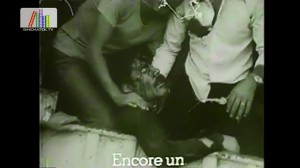
“Bu filmi ile Ümraniye 1 Mayıs mahallesindeki yoksul halkın barınma hakkı mücadelesi 1970’li yılların 2. yarısının atmosferinde veren bir film yapmış […]. 1977 senesinin 2 eylül günü 1 Mayıs Mahallesi’ne gecekondu yıkımı için gelen polisler ile mahalle halkı arasında çıkan ve 12 mahallelinin ölüp onlarcasının yaralandığı çatışmalar sırasında çeşitli sosyalist yapılar etrafında örgütlenmiş mahalle sakinlerinin gösterdiği direniş Türkiye’deki sosyalist mücadele tarihi içerisinde çok önemli bir yere sahiptir [...].” Sinematek.tv: http://sinematek.tv/2-gun-2-eylul-direnisi-1978/ (13 November 2019).
“The conflict between the District May 1 organized in various socialist collectives and the police that came to the district to demolish the shantytown, which resulted in 12 people living in the district killed on 2 September 1977 has an important place in the history of the socialist movement in Turkey [...]. [İshak Işıtan’s] film is about the poor people of Ürmaniye/District May 1’s a struggle for the housing right reflecting the atmosphere of the second half of the 1970s [...]. Sinematek.tv: http://sinematek.tv/2-gun-2-eylul-direnisi-1978/ (13 November 2019).
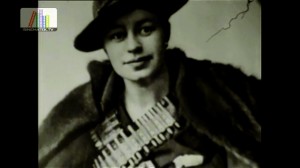
“‘Ben Milyonlarca emekçiden birisiyim barışçıyım ve devrimciyim’ diye başlıyor 12 dakikalık film. Mehmet Özgentürk seslendirmiş. Finlandiyadaki iç savaş ve devrimciler hakkında bilmediğiniz birçok şeyi içinde Enternasyonalin de olduğu Fince marşlar eşliğinde anlatıyor. 1956 yılında gerçekleştirilen 3 hafta süren büyük grevden başlayarak Finlandiya’daki mücadeleyi Nazım şiiri eşliğinde izleyeceksiniz.” Sinematek.tv: http://sinematek.tv/baris-kavgasi/ (30 October 2019).
“The film begins with the sentence, ‘I am one of the millions of workers; I am a pacifist and revolutionist.’ It was narrated by Mehmet Özgentürk. It tells the unknown story of Civil War in Finland and that of Finn revolutionists, synchronized with the local marches. You will watch the Finn revolutionary struggle—since the Great Strike of 1956, lasted 3 weeks—which is accompanied by a Nazım [Hikmet] poem.” Sinematek.tv: http://sinematek.tv/baris-kavgasi/ (30 October 2019).
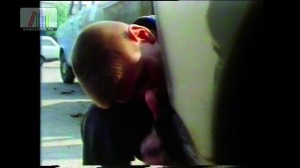
“O günlerde tam bir kültürel çöl olan İzmir’de sinema ile ilgili birşeyler yapabilmek (etkinlik, fim, yayın) çabası içindeyken, İstanbul öncesi kurucular arasında bulunduğum ve sinematek bölümünü yönettiğim İzmir Sinema ve Kültür Derneği’nin düzenlediği “Bağımsız Filmler’ temalı festivale filmleriyle davet ettiğim, tanıştığım Muammer Özer’le dostluğum ilerledi… Yıllar sonra İzmir’i ziyaret ettiği bir günde öğrencilerimden İbrahim Öğretmen ile (daha sonra Paris’e yerleşti, Gökşin Sipahioğlu ile uzun süre çalıştı) fotoğraf çalışmaları sırasında gözlediğim bir kenar semtteki artık camları değerlendiren işliklerden-işçilerden söz ettim. O günlerde Refik Durbaş’ın şiirinden, Livaneli’nin bir şarkısı da kulaklarımızdaydı.” Oğuz Makal, sinematek.tv: http://sinematek.tv/ciraklar-1980-2/ (9 November 2019).
“When I was trying to make something (a film, a publication, an event)—Izmir was like a ‘cultural desert,’ I started getting off with Muammer Özer whom I invited to the “Independent Film Festival” that İzmir Sinema ve Kültür Derneği [Izmir Cinema and Cultural Association which I established in Istanbul organized... After years, when one of my students—İbrahim Özen who moved to Paris and worked with Gökhan Sipahioğlu—came to Izmir, I talked to him about child workers trying to pick up waste glass in trash. During the course of these days, Refik Durbaş’s poem [Çırak Aranıyor/An Apprentice Wanted] and one song of Liveneli were ringing in our ears.” Oğuz Makal, sinematek.tv: http://sinematek.tv/ciraklar-1980-2/ (9 November 2019).
"On the challenge of social problems facing the nation's churches. Illustrates poverty, gambling, alcoholism, and drug abuse among teenagers and adults in New York City slum areas." National Archives.
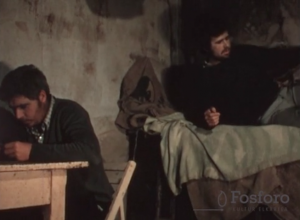
Un hombre vaga por las calles de un pueblo buscando tabaco en botes de basura o en el camino. Al entrar a un bar, un hombre nota que está buscando algo, por lo que lanza tabaco al suelo y cuando el primero se agacha a recogerlo, el otro lo tira al suelo mientras todos en el bar se ríen de él. Al regresar al cuarto en el que vive, otro hombre se encuentra ahí descansando. Los hombres tienen una breve conversación sobre cuándo se irá el otro, mientras que este da una excusa y le pide algo de tabaco al primer hombre. El primero se niega y le dice que el tabaco es muy difícil de conseguir, provocando la ira del segundo, quien decide asesinarlo apuñalándolo por la espalda. Después de enterrar su cuerpo, vuelve al cuarto donde se siente culpable y después de llorar por un rato, decide suicidarse.
A man wanders the streets of a town looking for tobacco in trash cans or the road, he enters a bar and a man notices that he is looking for something, he throws some tobacco on the floor and when the first man tries to reach it, he shoves him to the floor while the rest of the men in the bar laugh at him. When he goes back to the room he lives in, there is another man there resting. They have a small conversation about when the man lying down will leave, he gives an excuse and then asks the other for some tobacco. The first man refuses and tells him it is too hard to get, provoking the anger of the second one who then he chooses to kill him by stabbing him in the back. After burying his body he goes back and feels guilty, after crying for some time, he chooses to kill himself.
A short film dealing with the subject of class inequality in England.
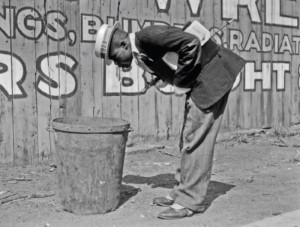
"Mr. Motorboat's Last Stand, written and produced by John A. Flory, who was assisted in photography by Theodore Huff, ACL, carries the subtitle, A Comedy of the Depression. It has, however, nothing in common with the typical motion picture comedy but is, instead, one of the very few films made each year that represent an intelligent attempt at experimentation with the motion picture medium. It is a story of Mr. Motorboat, an unemployed negro, who lives as elegantly as circumstances will permit in an automobile dump and who sells carefully washed and polished apples on a street corner. The picture turns into fantasy as Mr. Motorboat appears to ride to work in the morning in one of the cars of the dump that stands motionless without its wheels. Then the fantasy becomes more complete when he makes a bit of money and uses it as bait with which to fish in Wall Street. This he does literally and actually and with marvelous results until the crash of 1929. Simultaneously with the explosion of the prosperity bubble, Mr. Motorboat's competitor smashes his apple stand and the picture ends in a magnificent chase sequence, Mr. Motorboat after the competitor. This picture is photographed superbly well, and the editing is as smooth as that of the professional studio product. It is filled with remarkable directorial touches and cinematic symbolism and, although it suffers to some extent from the haphazard admixture of fantasy and realism, it is decidedly the best experimental film of the year." Movie Makers, Dec. 1933, 522.
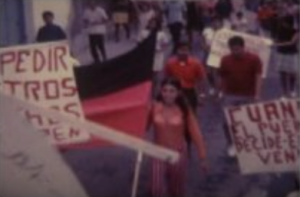
"El guión tenía una fuerte influencia de La hora de los hornos, y tendía a la explicación pedagógica de las condiciones de opresión, mostrando la diferencia entre la forma de vida de ricos y pobres y con una explicación sencilla de cómo el capitalismo sienta las bases de una explotación que finalmente es la base de las razones de la huelga [El filme muestra la huelga de Rivetex en Cuernavaca] . El título de la película (Nosotros sí existimos) jugaba con el término legal que había declarado la huelga inexistente" (Vázquez Mantecón, 2012). "The script had a strong influence of The hour of the furnaces , and it tended to a pedagogical explanation of the conditions of oppression, showing the difference between the way of life of the rich and the poor, along with a simple explanation of how capitalism sets the basis for exploitation, which is the origin of the strike [The film portrays the Rivetex strike in Cuernavaca]. The title of the film [We do exist] played with the legal term that had declared the strike non-existent" (Vázquez Mantecón, 2012).
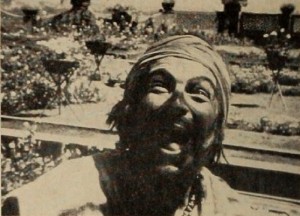
"J. N. Unwalla has chosen a simple morality tale for the theme of this colorful film from India. A beggar pleads for alms from passersby with poor success. There appears suddenly a figure who promises him wealth if he will eschew avarice and greed. As a shower of golden coins overflows his lap, however, he begs for "one dinar more." The point of the tale is proved when this evidence of his greed causes the wealth and the figure to disappear. Although employing interesting camera viewpoints to give diversity, the single setting in a Bombay courtyard suggests a stage play rather than a motion picture." Movie Makers, Dec. 1949, 470.
"The Other Americans was a winner of a special Judges' Award for the Best Public Service Film in the "C" Classification. It's a long film, 52½ minutes in all, but it is filled with what poverty really is. Ms Julian Krainin and Dewitt Sage of Forest Hills, N. Y. have created a film about the Negroes, the Puerto Ricans, the Indians, the Coal Miners, the Farmers and many others that are poor, poor, poor. The average American will be surprised at how poverty-stricken other Americans are. The film is a mind-opener and well deserves the special award that it received," PSA Journal, Mar. 1970, 43.
Total Pages: 2